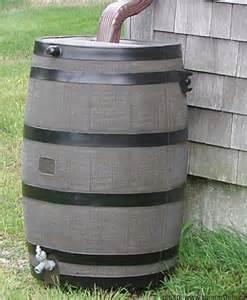
rainwater catchment system
Recently I’ve been inundated with requests from readers to know how I’ve personally prepared for the future. These requests have come about as a result of my blog post of Gerald Celente’s economic forecasts (see link here). In fact, I’ve even created an entirely new blog called Preparedness Pro, devoted exclusively to emergency preparedness in the categories of food (including cooking), water, first aid, self-defense, finances, and emotional preparedness and more.
What makes me a pro? I’ve been practicing personal preparedness doggedly for most of my life. Our house has three full rooms of necessary emergency supplies. Usually, instead of going to the store, I just go downstairs to our food storage room, grab what I need, and replenish it about every 6 months or so. It will be up to you to decide whether or not what I share with you has merit.
First Things First—WATER!
If you have not started preparing for an emergency, do not start with food. Start with WATER! If you’ve already started a sufficient emergency supply food storage, you are probably like the majority of individuals and have put off storing water. “Where am I going to store those ugly barrels?” you ask? Believe me, that’s the last thing you’re going to care about when you need water.
How much water should I store?
You can go without food a heck of a lot longer than you can water. I know this may sound a bit overwhelming, but you really need to store enough water to provide you and your family with 1 gallon per day—minimum—for at least 3 months. Allow me to restate this. 1 gallon per person is MINIMUM. That’s a lot. But you don’t need to go back too far in history to realize that such a need could exist. Think of the hurricanes our nation has had in recent history. Is your area ripe for an earthquake? What if some moron crashes their chemical truck into your water supply?
Keep in mind that that one gallon of water is not just for drinking. It’s for hygiene, (and don’t even think that you’ll avoid bathing all together…this will foster serious illnesses, among other things) cooking, toilet use, laundry, and cleaning.
How do I store my water?
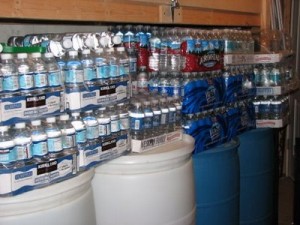
Water storage
Store your water in NEW barrels. Please don’t store water you intend to use for drinking and cooking in barrels that have been used for something else. You will suffer, indeed. (It’s fine to use those kinds of barrels for water you will use exclusively for cleaning, etc.)
Please, please, please do not store your water in empty milk or soda pop bottles. They deteriorate. (Although if you have to choose one of them, pick the soda pop bottles instead. They last a bit longer)
Should I store purified water?
Don’t treat your water before storing it. Chance are very good that it’s already been sufficiently treated by your municipality. Besides, I would recommend treating your water prior to using it for drinking or cooking anyway. To do this you want to use 8 drops of pure Clorox per gallon of water.
You can fill your water barrels through the garden hose. As long as you let the water run through the hose a bit and there aren’t any bugs sitting in it, you’re fine. Surely you drank out of a hose when you were little and you’re no worse for wear, right? If you’re a purist, you can purchase a marine hose that is lined with an anti-bacterial coating. Those are readily available at your local hardware store.
Keep in mind that the water in your water heater, water bed, and toilet tanks is usable as well.
Iodine tablets, colloidal silver, and quality camping water filters are also a good preparedness step in the event you’re required to use water from sources you’re not familiar with.
How often do I replace the water?
We empty and refill our water barrels every two years. You don’t need to do it that often, but we’re a bit fanatical about things. You’re fine to go out 5 years prior to refilling them as long as it’s good water to begin with. You will want to aerate your water though prior to drinking it.
Doing this is as simple as pouring it a few times from one container to another, such as a couple of pitchers.
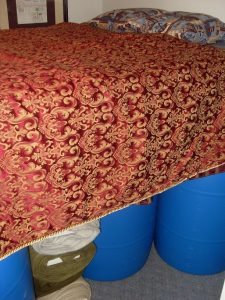
Voila. A Water Bed.
Where am I supposed to store all this water?
If you’re in a small apartment, you will be pleasantly surprised how easily you can disguise a water barrel as an end table with a small round piece of plywood and a classy decorative tablecloth. We are fortunate enough to have enough space in our basement and have several of them lined up and then have plywood stacked on top of them to begin shelving for our food storage.
Note to wives: If your overzealous husband convinces you to store “an extra” eight 50-gallon barrels under one of the guest beds, you may want to think twice. It’s a family joke now when folks come to stay with us and sleep in the “water bed.” Though water bricks would be a much better solution.
Don’t buy into the myth that you can’t store your water barrels on cement. Clarification is that you should not store your water on cement that gets heated by the sun. So if you’re storing it outside, the sun will heat the cement, which will then heat your water. This makes water taste nasty and leaches the plastic into your water. If you’re storing them outside, place the barrels on top of 2 x 4’s.
You can store your water barrels outside in freezing weather, but you run the risk of them freezing and cracking. At the very least, you should not fill them up to maximum capacity to allow for the freezing expansion.
Conserving Water in an Emergency
Consider ways to conserve water in an emergency as well. Storing paper goods such as paper plates and cups will eliminate cleaning and avoid using water, and learning to cook with a pressure cooker which uses a minimum amount of water for cooking is also a good idea. (more on pressure cooking in a future blog.)
In view of some of the e-mails I’ve received as a result of this article, I just want to clarify…you only want to use HOUSEHOLD chlorine, such as Clorox. And remember, don’t treat the water prior to storing it if you’re getting it from your tap. You’ll want to treat it after it comes out of those barrels and containers, ideally, except to clean with.
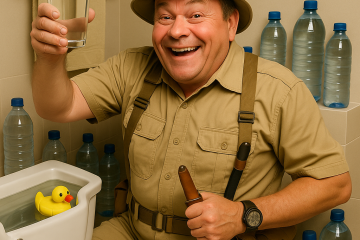
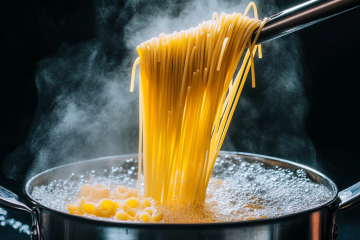
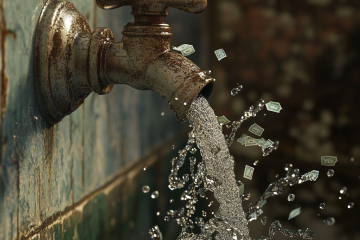
12 Comments
Barbara · August 9, 2009 at 12:37 am
Excellent info on water storage. You show an amazing resourcefulness with a can-do attitude that we would all do well to emulate! Thanks for sharing how you “do it”.
Barbara · August 9, 2009 at 12:37 am
Excellent info on water storage. You show an amazing resourcefulness with a can-do attitude that we would all do well to emulate! Thanks for sharing how you “do it”.
Troy Billington · August 11, 2009 at 9:05 pm
I have an urban survivalist website which has filtration, chemical stabalizers, storage (such as the barrels you show above.
I’ve lived in Florida all my life and I’ve prepared for and been through many hurricanes. It’s amazing that people don’t plan and prepare even for the KNOWN event such as a hurricane.
Folks, if you don’t have adequate “safe” drinking water, you’re not going to make it very long at all…days at best.
I also advocate collection of 5 gallon buckets so you can collect water for things like washing, flushing toilets (came in very handy during Hurricane Francis). Use your ‘grey water’ for everything and save your potable clean water exclusively for cooking, drinking and brushing your teeth.
Troy Billington · August 11, 2009 at 9:05 pm
I have an urban survivalist website which has filtration, chemical stabalizers, storage (such as the barrels you show above.
I’ve lived in Florida all my life and I’ve prepared for and been through many hurricanes. It’s amazing that people don’t plan and prepare even for the KNOWN event such as a hurricane.
Folks, if you don’t have adequate “safe” drinking water, you’re not going to make it very long at all…days at best.
I also advocate collection of 5 gallon buckets so you can collect water for things like washing, flushing toilets (came in very handy during Hurricane Francis). Use your ‘grey water’ for everything and save your potable clean water exclusively for cooking, drinking and brushing your teeth.
Sheryl · May 9, 2011 at 4:26 pm
Thank you for all the great information. We have a few 55 gal barrels that are filled with water from our well. This water is not treated at all. The water in these barrels hasn’t been changed out for probably 9 or 10 years. I’m thinking that there is probably something growing on the inside of those barrels. What do we need to do to get clean, fresh water in those barrels again? How do I clean the inside of the barrels? And do I add any Clorox to the water after we refill?
Kellene · May 9, 2011 at 4:38 pm
Usually I would suggest treating the water as you retrieve it from the storage container, but if you’re convinced that something is growing in there, there I would indeed clean it out with bleach and then refill.
Sheryl · May 9, 2011 at 4:26 pm
Thank you for all the great information. We have a few 55 gal barrels that are filled with water from our well. This water is not treated at all. The water in these barrels hasn’t been changed out for probably 9 or 10 years. I’m thinking that there is probably something growing on the inside of those barrels. What do we need to do to get clean, fresh water in those barrels again? How do I clean the inside of the barrels? And do I add any Clorox to the water after we refill?
Kellene · May 9, 2011 at 4:38 pm
Usually I would suggest treating the water as you retrieve it from the storage container, but if you’re convinced that something is growing in there, there I would indeed clean it out with bleach and then refill.
John · September 8, 2013 at 3:08 am
I no longer have space in my
I no longer have space in my house for water storage. I have lots of water stored, but I want more. So, what I have done is to store water in small bottles, for example, an empty glass root beer bottle. I fill it about 3/4th of the way, then I add 1 drop of lugol’s 2 percent iodine, then I screw the original cap back on it, and then I hide these bottles in the forest behind my house, or bury them under cement stepping stones, or I hide them in the thick bushes around my house. I have even these small containers of water on other peoples property where they are totally invisible. I have water stashed all over the place within a mile of my home. I got water stashed in my locker at the gym. I have a 5 gallon water container in the trunk of my car. I have cache of small water containers leading out to my bug out place. The idea here, is that if I am ever forced out of my home when SHTF, I have plans to return back to my home when things “look” safe. When I come back, I should be able to find buried, hidden, and stashed away small containers of water, and water on my property and just about every where. Ha! Only I know where the water and food is buried.
Preparedness Pro · September 15, 2013 at 4:15 am
Be sure you keep in mind the
Be sure you keep in mind the need to conserve physical energy too though–especially when it comes to your water.
John · September 8, 2013 at 3:08 am
I no longer have space in my
I no longer have space in my house for water storage. I have lots of water stored, but I want more. So, what I have done is to store water in small bottles, for example, an empty glass root beer bottle. I fill it about 3/4th of the way, then I add 1 drop of lugol’s 2 percent iodine, then I screw the original cap back on it, and then I hide these bottles in the forest behind my house, or bury them under cement stepping stones, or I hide them in the thick bushes around my house. I have even these small containers of water on other peoples property where they are totally invisible. I have water stashed all over the place within a mile of my home. I got water stashed in my locker at the gym. I have a 5 gallon water container in the trunk of my car. I have cache of small water containers leading out to my bug out place. The idea here, is that if I am ever forced out of my home when SHTF, I have plans to return back to my home when things “look” safe. When I come back, I should be able to find buried, hidden, and stashed away small containers of water, and water on my property and just about every where. Ha! Only I know where the water and food is buried.
Preparedness Pro · September 15, 2013 at 4:15 am
Be sure you keep in mind the
Be sure you keep in mind the need to conserve physical energy too though–especially when it comes to your water.
Comments are closed.